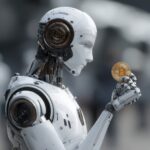1. AI Robotics and Blockchain: The Smart Factory of the Future
The convergence of AI-driven robotics and blockchain technology is reshaping industrial manufacturing. Smart factories now use AI-powered robots for automation, efficiency, and predictive maintenance — while blockchain ensures supply chain transparency, secure data sharing, and verifiable machine-to-machine transactions. Together, they create a decentralized and trustworthy ecosystem where robots can operate autonomously while maintaining accountability.
Smart factories now use AI-powered robots for automation, efficiency, and predictive maintenance — while blockchain ensures supply chain transparency, secure data sharing, and verifiable machine-to-machine transactions. Together, they create a decentralized and trustworthy ecosystem where robots can operate autonomously while maintaining accountability.
2. AI Robots That Trade: Autonomous Agents in Crypto Markets
Imagine robots that don’t just build cars but also build portfolios. AI-powered trading bots, when combined with blockchain-based smart contracts, can act as autonomous financial agents in crypto markets. These robots can analyze market sentiment, execute trades, and even manage risk without human input. While this opens up vast opportunities for efficiency and profit, it also raises new questions about regulation, algorithmic fairness, and trust in AI-managed capital.
AI-powered trading bots, when combined with blockchain-based smart contracts, can act as autonomous financial agents in crypto markets. These robots can analyze market sentiment, execute trades, and even manage risk without human input. While this opens up vast opportunities for efficiency and profit, it also raises new questions about regulation, algorithmic fairness, and trust in AI-managed capital.
3. Crypto-Powered Robotics: Will Tokens Drive Human–Robot Collaboration?
In a tokenized economy, robots could be incentivized and rewarded directly with crypto coins for tasks they complete. Whether in warehouses, delivery systems, or personal assistance, blockchain-based tokens could serve as the “paychecks” of tomorrow’s robotic workforce. This model enables seamless collaboration between humans and machines, but it also sparks debate: Will tokenized incentives enhance productivity, or create new ethical dilemmas around labor, ownership, and machine rights?
Whether in warehouses, delivery systems, or personal assistance, blockchain-based tokens could serve as the “paychecks” of tomorrow’s robotic workforce. This model enables seamless collaboration between humans and machines, but it also sparks debate: Will tokenized incentives enhance productivity, or create new ethical dilemmas around labor, ownership, and machine rights?
4. Swarm Robotics Meets Blockchain: Decentralized Intelligence at Scale
 Swarm robotics mimics nature — think of ants or bees working together — but powered by AI. Adding blockchain into the mix allows these distributed robotic systems to coordinate securely, share resources, and make collective decisions without a central authority. From disaster relief to supply chain logistics, swarm robotics governed by decentralized ledgers could unlock massive efficiency and resilience while redefining how autonomous systems scale in the real world.
Swarm robotics mimics nature — think of ants or bees working together — but powered by AI. Adding blockchain into the mix allows these distributed robotic systems to coordinate securely, share resources, and make collective decisions without a central authority. From disaster relief to supply chain logistics, swarm robotics governed by decentralized ledgers could unlock massive efficiency and resilience while redefining how autonomous systems scale in the real world.
5. Humanoid Robots with Crypto Wallets: The Future of Autonomous Finance
 What happens when humanoid robots can own and manage digital assets? With embedded crypto wallets, AI-driven robots could pay for their own maintenance, purchase cloud services, or even invest in tokens. This creates the possibility of truly self-sustaining machines operating in financial markets or consumer-facing industries. While the concept feels futuristic, the infrastructure — crypto wallets, smart contracts, and decentralized finance (DeFi) — already exists, hinting at a new era of autonomous finance.
What happens when humanoid robots can own and manage digital assets? With embedded crypto wallets, AI-driven robots could pay for their own maintenance, purchase cloud services, or even invest in tokens. This creates the possibility of truly self-sustaining machines operating in financial markets or consumer-facing industries. While the concept feels futuristic, the infrastructure — crypto wallets, smart contracts, and decentralized finance (DeFi) — already exists, hinting at a new era of autonomous finance.
6. Tokenizing Robotics: How Crypto Coins Fuel Automation Ecosystems
Tokenization is turning robots into economic participants . By linking robotics platforms with blockchain-based tokens, ecosystems can be created where machines pay, trade, and interact seamlessly. Tokens could represent access to robotic labor, usage rights for automation systems, or collective ownership of fleets of machines. This model not only enables efficiency but also democratizes access to robotics, allowing retail investors and enterprises alike to participate in the robotic economy.
. By linking robotics platforms with blockchain-based tokens, ecosystems can be created where machines pay, trade, and interact seamlessly. Tokens could represent access to robotic labor, usage rights for automation systems, or collective ownership of fleets of machines. This model not only enables efficiency but also democratizes access to robotics, allowing retail investors and enterprises alike to participate in the robotic economy.
7. Healthcare on the Blockchain: AI Robots in Surgery and Elder Care
AI-powered robots are rapidly advancing in healthcare — from surgical assistants with precision greater than human hands to robotic caregivers supporting elderly populations. By integrating blockchain, sensitive medical data can be secured, verified, and shared transparently across systems. Tokenized payments could streamline insurance claims and cross-border healthcare, while smart contracts could automate billing between patients, hospitals, and insurers. This fusion promises efficiency, but also raises questions about trust, liability, and patient privacy when robots operate autonomously.
8. Autonomous Drones & Defense: Blockchain Securing AI-Powered Security Systems
Military and civilian security are entering a new era with AI-driven drones, surveillance robots, and autonomous defense systems. Blockchain can act as the backbone for decentralized command structures, ensuring transparency in decision-making and preventing hacks or rogue control. Decentralized ledgers could track missions, log accountability, and provide tamper-proof oversight. While the benefits for disaster response, border security, and search-and-rescue are immense, the rise of “blockchain-armed robots” also sparks debates about ethical warfare and the risks of handing too much autonomy to machines.
9. The Ethics of Robot Wallets: Taxation, Ownership, and Legal Identity
If humanoid robots or autonomous agents can hold crypto wallets, pay for services, and invest in tokens, should they also be subject to taxation and legal obligations? This article explores the provocative idea of robots as economic citizens. With wallets, they can act like businesses — buying resources, selling labor, and paying fees. Blockchain provides transparent records of their activity, but ownership becomes tricky: do the profits belong to their human creators, or could robots claim their own digital sovereignty? These questions point toward a new legal frontier where AI, finance, and law collide.
10. Green Machines: Blockchain-Coordinated Robots for Climate and Sustainability
Robotics and blockchain could team up to tackle global sustainability challenges. Swarms of AI-driven robots could monitor ecosystems, manage smart grids, plant forests, or clean oceans. Blockchain would provide a decentralized framework for verifying environmental impact and issuing tokenized rewards for climate-positive actions. Investors could fund eco-robot projects through green tokens, while communities track progress transparently. This model reframes robots not just as tools of efficiency, but as autonomous agents in the global fight against climate change.
